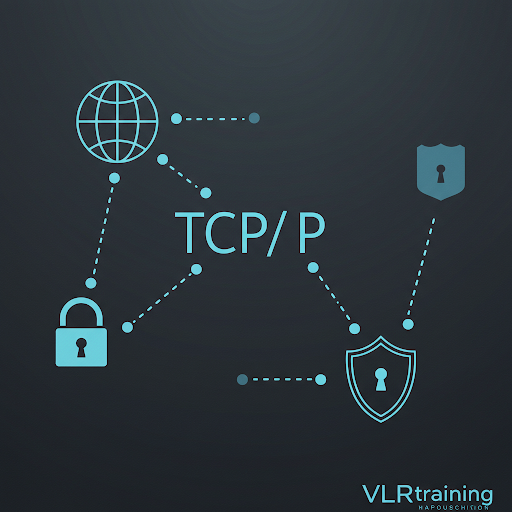TCP/IP Protocol Explained: Cybersecurity Essentials & Network Fundamentals
🌐 TCP/IP: The Internet’s Foundation 🧱
What is TCP/IP? 🌐🤝
TCP/IP (Transmission Control Protocol/Internet Protocol) is the foundational communication protocol suite 📜 that powers the internet and most modern networks. It defines how data is packaged 📦, addressed 📍, transmitted ➡️, routed 🗺️, and received 📥 across networks. Unlike the OSI model, TCP/IP uses a simplified 4-layer architecture:
- Application Layer 📱
- Transport Layer 🚚
- Internet Layer 🌐
- Link Layer 🔗
How TCP/IP Works ⚙️
Let’s break down the layers with an example of loading a webpage: 🌍
1. Application Layer 📱
- Purpose: Interfaces with user applications (e.g., browsers 🌐, email clients 📧).
- Protocols: HTTP 🌍, HTTPS 🔒, FTP 📂, SMTP 📧, DNS 🌐➡️🔢.
- Example:
- You type https://www.example.com in your browser. 🌐
- The browser uses HTTP/HTTPS to request the webpage. ➡️🌍
2. Transport Layer 🚚
- Purpose: Ensures end-to-end communication and data reliability ✅.
- Protocols:
- TCP (Transmission Control Protocol): Reliable, connection-oriented (used for web pages 🌐, emails 📧). 📦✅
- UDP (User Datagram Protocol): Fast, connectionless (used for streaming 🎥, VoIP 📞). ⚡🚀
- Example:
- The Transport layer breaks the HTTP request into segments. ✂️
- TCP adds sequence numbers for reassembly and performs a 3-way handshake 🤝 to establish a connection:
- SYN (Client → Server): “Can we connect?” 🤝
- SYN-ACK (Server → Client): “Yes, let’s connect.” ✅🤝
- ACK (Client → Server): “Confirmed!” 👍🤝
3. Internet Layer 🌐
- Purpose: Routes data packets across networks using IP addresses 📍.
- Protocols: IP (IPv4 🔢4️⃣/IPv6 🔢6️⃣), ICMP 📡, ARP 🌐➡️🚪.
- Example:
- The segments are wrapped into IP packets 📦 with source/destination IP addresses (e.g., your IP 192.168.1.100 🏠 → server IP 93.184.216.34 🌐).
- Routers 🗺️ use IP addresses to forward packets toward the destination. ➡️🌐
4. Link Layer 🔗
- Purpose: Transmits data over physical hardware (cables 🔌, Wi-Fi 📡).
- Protocols: Ethernet 🔌, Wi-Fi (802.11) 📡, MAC addresses 🚪.
- Example:
- IP packets are converted into frames 🖼️ with MAC addresses (e.g., your router’s MAC 00:1A:2B:3C:4D:5E 🚪).
- Frames travel via Ethernet/Wi-Fi to the next hop (e.g., your router 🚪🌐). ➡️🔗

TCP & IP: A Dynamic Duo 🤝🌐
TCP works in conjunction with IP. IP handles the “where” (addresses 📍), and TCP handles the “how” (reliable delivery ✅).
So, while TCP is a single protocol 📜, it operates within a framework of other protocols ⚙️ that are essential for network communication 🌐
TCP/IP Example: Sending an Email 📧➡️🌐
- Application Layer: Your email client uses SMTP to compose the email. 📧
- Transport Layer: TCP breaks the email into segments and ensures delivery. 📦✅
- Internet Layer: IP routes the packets to the email server’s IP address. 🌐
- Link Layer: Frames are sent via Ethernet/Wi-Fi to your router. ➡️🔗
Importance in Cybersecurity 🛡️🌐
TCP/IP is critical to securing networks, but each layer has vulnerabilities:
1. Application Layer Attacks 📱💥
- Threats: Phishing 🎣, SQL injection 💉, cross-site scripting (XSS) 💻.
- Defense:
- Use HTTPS (SSL/TLS) to encrypt web traffic. 🔒🌐
- Validate inputs to prevent injection attacks. ✅
2. Transport Layer Attacks 🚚💥
- Threats:
- TCP SYN Flood: Overwhelm a server with half-open connections (DDoS). 💥🚚
- Session Hijacking: Steal TCP session IDs. 🔑🚚
- Defense:
- Use firewalls 🧱 to block suspicious traffic.
- Implement rate limiting ⏱️ to mitigate DDoS.
3. Internet Layer Attacks 🌐💥
- Threats:
- IP Spoofing: Fake source IPs to hide identity. 🎭🌐.
- Man-in-the-Middle (MitM): Intercept unencrypted IP traffic. 👤➡️🌐.
- Defense:
- Use IPsec 🔒🌐 for encrypted IP communication.
- Enable ingress/egress filtering ✅ to block spoofed IPs.
4. Link Layer Attacks 🔗💥
- Threats:
- MAC Spoofing: Impersonate trusted devices. 🎭🚪.
- ARP Poisoning: Redirect traffic to an attacker’s device. ☠️🔗.
- Defense:
- Use 802.1X authentication 🔑🔗 for network access.
- Monitor ARP tables with tools like ARPwatch. 👁️🗨️🔍

Real-World Cybersecurity Scenarios 🌐🛡️
- DDoS Attack on a Web Server: 💥🚚
- Attackers flood the server with TCP SYN requests (Transport Layer).
- Mitigation: Deploy a cloud-based DDoS protection service. ☁️🛡️
- Phishing via HTTP: 🎣📱
- A fake login page (HTTP) steals credentials (Application Layer).
- Mitigation: Enforce HTTPS-only connections and use web filters. 🔒🌐
- IP Spoofing in a Botnet: 🤖🌐
- A botnet uses spoofed IPs to launch attacks (Internet Layer).
- Mitigation: Configure routers to block packets with internal IPs from outside. 🧱🌐
Key Tools for TCP/IP Security 🛠️🔍
- Wireshark: Analyze network traffic at all layers. 📡🔬
- Nmap: Scan for open ports and services (Transport/Internet Layers). 🚪🔍
- Snort: IDS/IPS to detect malicious traffic patterns. 🚨
- Firewalls (e.g., pfSense): Filter traffic based on IP/port rules. 🧱
Why TCP/IP Knowledge Matters for Cybersecurity 🔑🌐
- Threat Detection: Understand how attacks traverse layers. 🕵️♂️🔍
- Secure Design: Configure networks with defense-in-depth. 🛡️
- Incident Response: Trace attack paths using logs. 📊
Summary Table 📝🌐
| Layer | Protocols | Key Cybersecurity Threats | Defenses | Icon |
|---|---|---|---|---|
| Application | HTTP, DNS, SMTP | Phishing, XSS, SQLi | HTTPS, input validation, WAFs | 📱 |
| Transport | TCP, UDP | SYN floods, session hijacking | Firewalls, rate limiting | 🚚 |
| Internet | IP, ICMP | IP spoofing, MitM | IPsec, ingress filtering | 🌐 |
| Link | Ethernet, Wi-Fi | ARP poisoning, MAC spoofing | 802.1X, port security | 🔗 |
Export to Sheets
Key Takeaway 🔑
Understanding TCP/IP is essential for:
- Securing networks 🛡️ (e.g., patching vulnerabilities at each layer).
- Investigating breaches 🕵️♂️🔍 (e.g., analyzing packet captures in Wireshark).
- Ethical hacking 💻🔒 (e.g., exploiting weak TCP/IP configurations).

